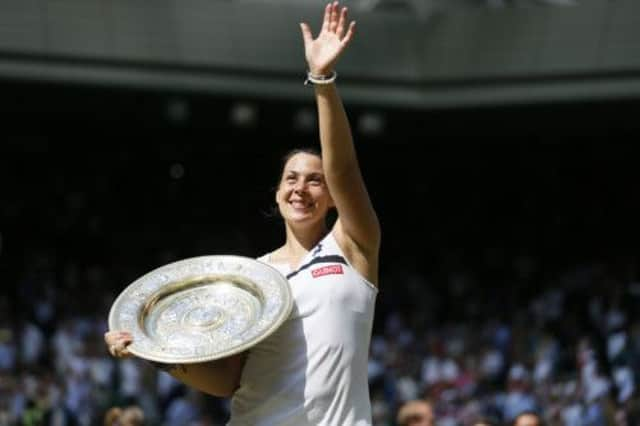Lori Anderson: Bartoli’s beauty burns bright


Marion Bartoli may have lacked the groomed blonde hair and pearly white smile of Maria Sharapova but on centre court the 28-year old French tennis player had the same gutsy determination and killer instinct. While this was enough to secure the Wimbledon title, it wasn’t enough to satisfy some male spectators who would prefer their elite sportswomen to seductively hitch up their white flippy skirts in a saucy reveal like the lithe limbed Tennis Girl in Athena’s iconic 1976 poster.
In what was a crass and sexist double fault, John Inverdale, the BBC presenter, said while commentating on the Wimbledon women’s final: “Do you think Bartoli’s dad told her when she was little: ‘You’re never going to be a looker. You’ll never be a Sharapova, so you’ll have to be scrappy and fight’?”
Advertisement
Hide AdAdvertisement
Hide AdSuch comments are proof of an uncomfortable fact. Beauty matters to people, even when it shouldn’t, such as on a tennis court.
For just as the BBC was issuing an apology, the Sunday papers were also reporting on a new survey carried out by the Medical Research Council (MRC) that appeared to prove what we had long suspected: that attractive teenagers turn into healthier and wealthier adults.
Professor Michaela Benzeval, the lead author of the report which was published last month, stated: “Adults rated as attractive as teenagers had more occupational and dating success and were slightly more intelligent than those rated as less attractive.”
The study, which spanned 25 years, began in 1987 and 1988 when 1,515 Glaswegian school pupils aged roughly 15 were rated by researchers on their attractiveness and measured for health, self esteem and intelligence.
The team also established the socio-economic status of their parents and discovered that those rated more attractive at 15 were living in more advantageous circumstances and were also less likely to report feeling “not good” about their health.
Curiously, there was no link found at the time between physical attractiveness and self esteem.
Twenty years later, the researchers were able to track down 942 of the original study group and discovered that those rated attractive at 15 had, on average and discounting their favourable circumstances at birth, achieved higher socio economic positions as adults.
As the report stated: “There was a statistically significant association between adult IQ and attractiveness and most of the socio-economic outcomes, with respondents rated as more attractive at 15 being in more favourable circumstances at 36. Attractive females had stronger occupational advantages than attractive males.”
Advertisement
Hide AdAdvertisement
Hide AdAs Prof Benzeval explained: “Perceived attractiveness may lead to individuals having a greater sense of self-worth and self-esteem.
“Evidence suggests that attractive adults are more extroverted, have better social skills and higher self-confidence than those rated as less attractive.”
“Yes,” I hear you cry: “but who decides what is or is not attractive? Aren’t we all beautiful unique snowflakes?”
Sadly, no. Beauty is almost a mathematical formula, with Plato concluding that the ideal face width should be two-thirds of its length, with the nose no longer than the distance between the centre of the eyes.
The Greek philosopher’s “golden proportions” were embraced by a culture which saw beauty as the perfect porcelain mask and one that also reflected inner qualities such as courage and self control.
Today scientists have developed Plato’s notions and shown through rigorous testing that symmetry is inherently attractive to the human eye.
But why are we drawn to symmetry and so to beauty? Scientists believe that we value beautiful people as mates and that we see this symmetry as a reflection of a strong immune system.
It’s really their robust genes to which we are most attracted, their inner beauty.
Advertisement
Hide AdAdvertisement
Hide AdPsychological research also suggests that people choose mates with a similar level of attractiveness, the evolutionary theory being that mating with someone who has similar genes ensures that one’s own genes are conserved.
Like the poor, the beautiful will always be with us and throughout history attractive people have always held a favoured place in society – after all, Helen of Troy launched a thousand ships with only the perfection of her face.
The question is whether today’s modern society has seen our fixation with physical appearance swell up into a dangerous obsession.
When a BBC commentator feels comfortable lobbing insults into a tennis match and points out to millions of viewers, who he clearly felt would agree with his characterisation, that a player is unattractive, then the answer would appear to be yes.
The problem is that we live in the most visual age in human history.
Photographs are more ubiquitous than ever and women are now having facelifts to look better on Face Time. If the MRC’s study was repeated today I’d be willing to bet that this time it would find a link, at 15, between attractiveness and self worth.
The only thing we can do is recognise the importance of physical attractiveness in society, but keep a sense of perspective and manners.
As Bartoli demonstrated when told of Inverdale’s comments: “Have I dreamt about having a model contract? No. But have I dreamed about winning Wimbledon. Absolutely.”
Game, set and match, Miss Bartoli.